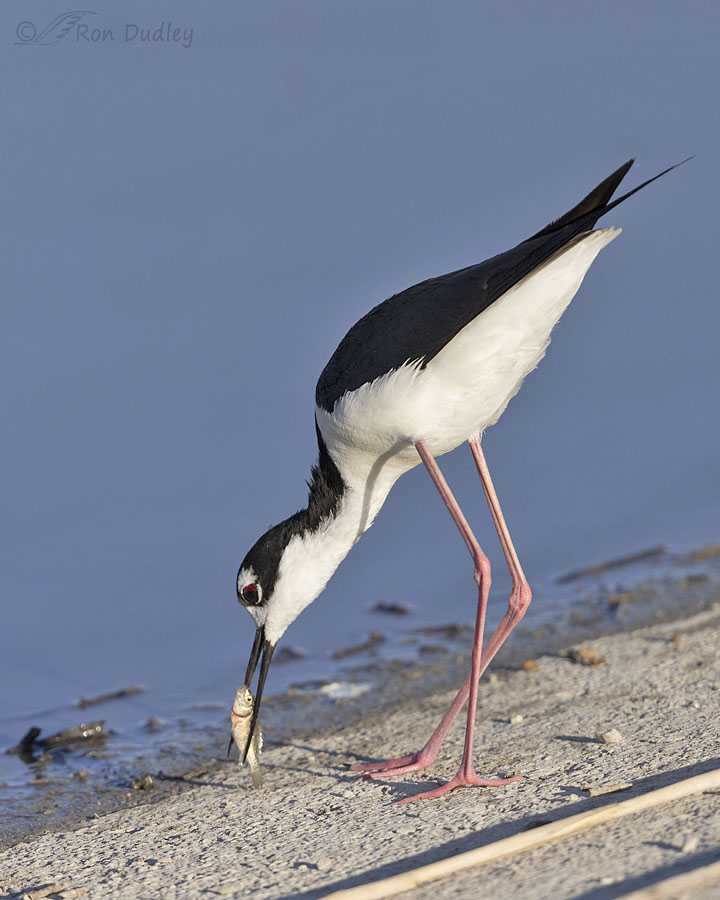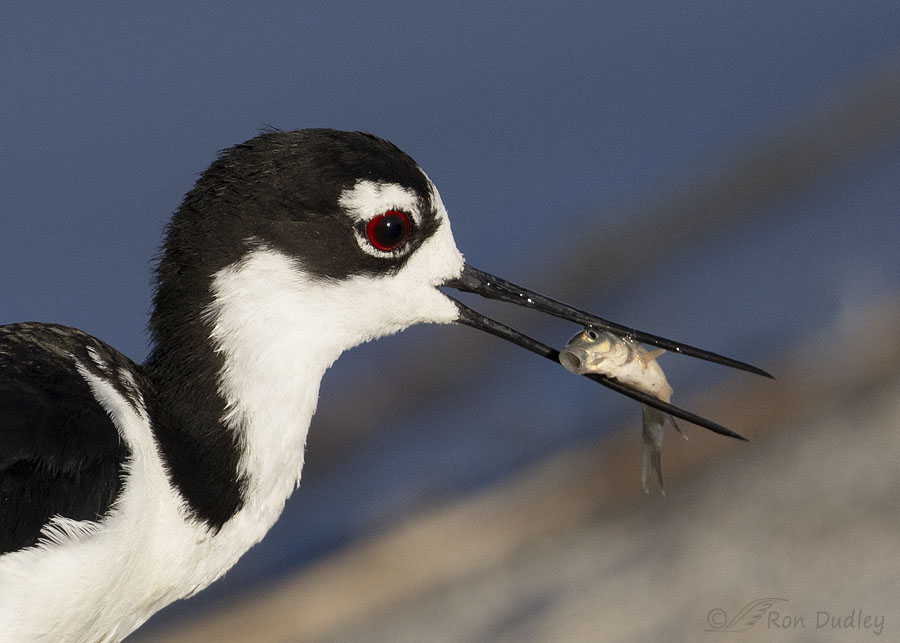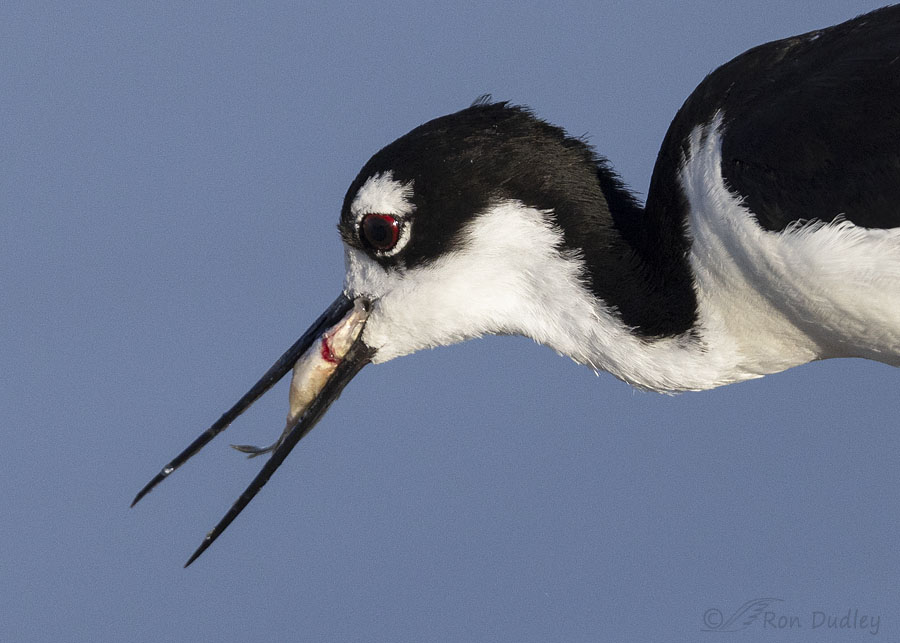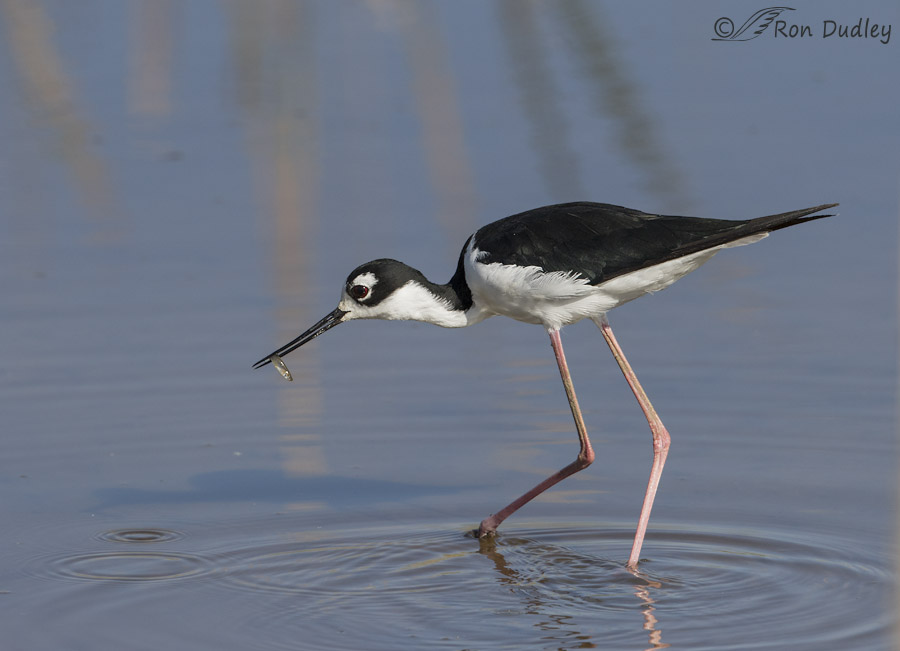If you’re a stilt, size matters.
Four days ago I slowly drove to the top of a boat ramp next to a pond at Bear River MBR with the intent of photographing the Western Grebes that habitually hang out there. I actually got my pickup stopped at the top of the ramp and one of the grebes in my viewfinder before I realized that there was a male Black-necked stilt at the bottom of the ramp at the water’s edge. He was so close to me I could barely fit him in the frame.
Even with me so close he didn’t fly off because he was preoccupied with something else.

He was trying to swallow a fish, a very large fish for a stilt, and he was having no luck at all.
The diet of Black-necked Stilts consists primarily of aquatic invertebrates that are usually so small I can barely see them through my lens, even when I’m close. They’re known to eat the occasional fish but only very small ones and in all the years I’ve been photographing birds I’ve only documented a stilt eating a fish one other time (interestingly, avocets seem to eat fish more often.)
I have no idea how long he’d been trying to swallow the fish before I arrived but I had the distinct impression that it had been a while. He was one determined bird.

This closeup gives us a pretty good look at why the size of the fish was pushing the limits for a stilt. Their mouth opening, where the base of their highly specialized bill meets their head, is very small, both horizontally and vertically. Anything they eat has to pass through that small opening and this fish was right at the limit of what was possible for a stilt.

Time after time he got the fish this close to being swallowed and then had to give up and start over again. I spent nearly three minutes with him and took 229 photos before he eventually succeeded in swallowing the fish, with his back to me of course.
Each time he failed he would dip the fish back into the water before trying again. That’s a behavior I often see with fish-eating birds, grebes for example, and it’s my half-baked theory that they do it to wet the fish and make it more slippery again so it’s easier to swallow.

Prior to four days ago, this is the only stilt I’d ever documented eating a fish and that was back in 2015. On those unusual occasions when stilts eat fish, this tiny one is more typical of the size they consume.
And that’s why the size of this latest fish got my attention.
Ron


Fascinating! I’m pretty impressed that he got that huge fish down the trap at all. Kudos to him and kudos to you for the tack-sharp shots of the process!
Have you had occasion to use your new out-of-truck contraption lately? I’ve been wondering how it’s working.
Marty, yes, I used it at Bear River a few days after I built it. It worked as it was intended – meaning well. Don’t think I’ll even have to make any modifications.
Neat capture. I think many of the birds “tenderize” the fish making the fish easier to swallow. Nice he got it down, that is a nice morsel for a stilt.
Thanks, April. Nice morsel indeed.
WOW! These photos are sharp as a tack!! Excellent capture and lesson. That is a small mouth opening.
Thanks, Kathleen. For noticing the sharpness too.
Super series Ron,thanks for sharing!
Charlotte Norton
Thanks, Charlotte.
Their bills certainly indicated that large items/fish are NOT the preferred menu item! 😉 Great Blue Herons occasionally have “eyes bigger than their stomachs also even if fish are part of their diet…..
Heat and smoke making things miserable here at present with more fires starting in state all the time with storms that are mostly dry…… 🙁
Sorry about your smoke and heat, Judy. The monsoons are finally here so it’s cloudy and cooler but no rain yet.
Very interesting and informative and of course excellent photos. I have never watched a Stilt eat a fish. That bill is not really made for eating fish of any size. All the wadding and shore birds often struggle with the fish they catch. Fortunately we have hands, but that too can be a curse because we humans so often overeat whereas our birds eat what they need.
“I have never watched a Stilt eat a fish.”
It’s unusual for them to do it so I’m not surprised. Thanks, Everett.
Re the 2nd photo- the fish looks like he is saying- “You’re not supposed to eat fish! Put me down!”
Great series of shots. Your photos make me want to move back home – miss the birds seen out west.
Thanks, Marcia. Enjoy the birds you have.
Did not know that. Another lesson learned from FP.
Photo #2 is an amazing closeup.
“Photo #2 is an amazing closeup.”
Thanks, Michael. I actually had quite a few photos like that one to choose from – one of the benefits of being so close.
I am glad that he finally succeeded, but wonder whether the energy it took made the effort worthwhile…
Interesting point about energy efficiency, EC.